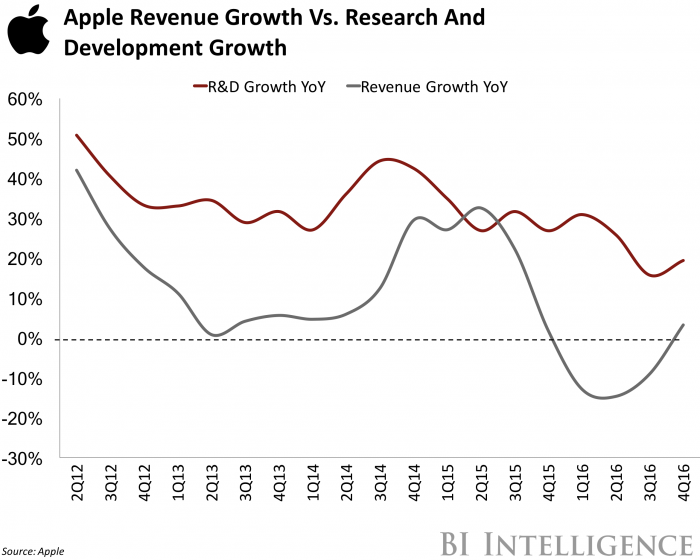This story was delivered to BI Intelligence Apps and Platforms Briefing subscribers. To learn more and subscribe, please click here.
Apple is pouring money into research and development (R&D) in an attempt to improve products that don’t currently generate revenue, but might in the future, according to remarks made by Apple CFO Luca Maestri at the Goldman Sachs investor conference Tuesday.
The company spent a massive $2.8 billion on R&D in Q4 2016, bringing the segment to nearly $10.5 billion in total for the year.
It’s normal for R&D to increase in line with growth and new product development, but Apple’s annual spend is up by roughly $4 billion since 2014, marking a uniquely significant bump.
There are three primary drivers behind this push:
- A growing product range: Apple’s hardware product range is growing. Apple has four primary hardware segments: the iPhone, iPad, Mac, and Apple Watch. Within each of these, the number of devices is expanding as well — for example, teh company now offers three iPhones instead of too. That growth begs a need for new or increasing investment.
- An expanding services segment: Apple’s Services segment, which comprises revenue from internet services, Apple Care, Apple Pay, licensing, and the App Store, is expected to grow to the size of a Fortune 100 company this year, according to Apple CEO Tim Cook. That’s about $28 billion in revenue for the year, or a year-over-year growth of 15%. To support this growth, Apple is building out the underlying services for iCloud, Siri, and Maps, which requires substantial investment.
- A greater focus on in-house technology development: As technological advancements continue to converge, Apple is working to keep its degree of difference from the rest of the industry and retain proprietary information. It’s doing this by directing its R&D spend in-house, and investing in building its own core technology, including work with processors and camera sensors for upcoming devices, which is costly and might bump spending.
Apple’s reliance on iPhone revenue makes innovation and product improvement top priorities. The company’s revenue is primarily based on income generated by the iPhone. The pool of first-time smartphone buyers who can afford the iPhone is shrinking, which means the company needs to convince users on other platforms to switch to iOS to find continued growth. Innovation is one way to do that. And as Apple continues to develop in emerging categories, like augmented reality (AR), virtual reality (VR), and the self-driving car space, it’s unlikely that R&D spend will slow down any time soon.
Cloud computing — on-demand, internet-based computing services — has been successfully applied to many computing functions in recent years.
From consumer-facing, web-based productivity apps like Google Docs to enterprise database management suites, the tools businesses rely on are increasingly moving to the cloud.
But developing a cloud strategy is no easy task. Public cloud solutions will likely come to dominate the market over the next decade, but business constraints, such as security concerns and the limitations of existing infrastructure, make it difficult for companies to fully adopt the public cloud right now.
That means that hybrid clouds,in which multiple cloud implementations (including public and private) are connected,will remain popular for the time being, at least until these constraints are addressed. The tech giants that dominate the IaaS market — Amazon, IBM, Microsoft, and Google — are constantly expanding their offerings to address current business constraints as they compete for market share.
Christina Anzalone, senior research analyst at BI Intelligence, Business Insider’s premium research service, has compiled a detailed report on cloud computing that evaluates the current business considerations for the various cloud solutions and provides an outlook on the state of the market.
Here are some of the key takeaways from the report:
- Cloud computing solutions have gained traction because they’re flexible and cost efficient. Sixty-seven percent of companies used an Infrastructure-as-a-Service solution in 2015, like the cloud, for some part of their business, up 19% from the prior year.
- All cloud solutions provide certain benefits that are becoming increasingly essential to businesses in the digital age. These include on-demand self-service, rapid elasticity, and broad network access, among others.
- Security needs, demand predictability, existing infrastructure, and maintenance capabilities are key business considerations for enterprises choosing between cloud implementations.
- While hybrid cloud strategies will remain popular in the near term, the market is likely to shift toward the public cloud over time. That’s because costs are falling, providers are developing solutions that address main concerns with the public cloud, and business practices like agile development and data analytics are dependent on advantages the public cloud provides. However, industries that handle sensitive information, like financial services and healthcare, will likely prefer hybrid and private cloud strategies given regulatory restrictions.
- Amazon Web Services is the dominant cloud computing provider by market share, followed by Google, IBM, and Microsoft. Because the latter three companies have had little success taking on Amazon, market-share gains are likely to come at the expense of smaller competitors.
In full, the report:
- Explains the different cloud computing strategies and benefits of cloud computing.
- Evaluates key business considerations – security needs, demand predictability, existing infrastructure, and maintenance capabilities – for enterprises choosing between cloud implementations.
- Provides and outlook for trends and major players in the cloud computing market.
Interested in getting the full report? Here are two ways to access it:
- Subscribe to an All-Access pass to BI Intelligence and gain immediate access to this report and over 100 other expertly researched reports. As an added bonus, you’ll also gain access to all future reports and daily newsletters to ensure you stay ahead of the curve and benefit personally and professionally. >>START A MEMBERSHIP
- Purchase & download the full report from our research store. >> BUY THE REPORT

















